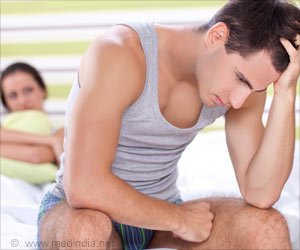Arthritis During Peak Reproductive Years may Down Fertility

Inflammatory arthritis, which includes rheumatoid arthritis, psoriatic arthritis, juvenile idiopathic arthritis and ankylosing spondylitis (inflammation of the spine, joints, and tendon-bone joins)–has been linked to male infertility, erectile dysfunction, and insufficient testosterone and/or sperm production (hypogonadism).
But the impact of inflammatory arthritis on men’s ability to father children remains largely unknown.
To explore this further, the researchers compared the fertility rate, or number of children per man, among men diagnosed with inflammatory arthritis based on their age at diagnosis; 30 or younger; between 31 and 40 (considered peak reproductive years); and 41 and older.
Advertisement
Participants were drawn from 8 different hospitals across The Netherlands between September 2019 and January 2021.
Some 628, who were older than 40 and who indicated that their family size was complete, filled in a questionnaire on the medical and fertility issues they had had before and after being diagnosed with inflammatory arthritis.
The researchers also compared the total number of pregnancies for each man, desired family size, the proportion of childless men and the results of medical assessments for fertility issues.
After adjusting for potentially influential factors, including current age, educational attainment, history of cardiovascular disease, a partner’s infertility, men diagnosed with any type of inflammatory arthritis before the age of 30 had significantly fewer children than men in the two other age groups.
These men had an average of 1.32 children compared with 1.56 for those diagnosed between 31 and 40, and 1.88 for those diagnosed when they were 41 or older.
Men diagnosed before or when they were 30 also had fewer pregnancies (1.45) than those diagnosed between 31 and 40 (1.73) or the older men (1.98).
In the Netherlands, between 1 in 5 and 1 in 4 men are childless. Among the participants, 143 (just over 22%) were childless, around two thirds of whom (99; 69%) were voluntarily childless.
Once again, the percentage of childless men was significantly higher among those diagnosed before or at the age of 30 (45;34%) than it was among those diagnosed between 31 and 40 (39;27%) and those diagnosed in their 40s (59;17%).
What’s more, the proportion of men who were involuntarily childless was significantly different among the 3 groups: respectively, 16 (12%); 15 (10%); and 13 (4%). Voluntary childlessness also differed 29 (25%); 24 (18%); and 46 (15%).
But among the voluntarily childless, the statement: ‘My disease reduced my desire to have children’ was graded higher by men diagnosed at the youngest age than by those in either of the two other age groups.
And significantly more men diagnosed before or at the age of 30 (17%) and between 31 and 40 (10%) said they were dissatisfied with their final number of children than men diagnosed when they were older (5.5%).
Around a third of these men gave as their primary reason(s) for having fewer children their diagnosis and/or the medical treatment associated with it.
Compared with the older age group, significantly more of those diagnosed before or during peak fertility years reported having been medically assessed for fertility problems, the outcome of which was poor sperm quality.
While the number of desired children was lower in men diagnosed before and during their peak reproductive years, this didn’t differ significantly among the 3 groups, overall, and it was similar to the figure reported per man for the general population of the Netherlands.
But, emphasise the researchers: “The difference between the desired and final number of children was significantly larger in men diagnosed before and during the reproductive [years], indicating that the lower fertility rates are primarily affected by reduced fertility potential and not by a reduced desire for parenthood.”
This is an observational study, and as such, can’t establish cause. And the researchers point out several caveats, including a low response rate to the questionnaire (628 out of 1841 men), while men with fertility problems might be more willing to take part in this kind of research, so representing a self-selected group.
Infertility rates were also higher among the partners of men diagnosed before or at the age of 30.
Nevertheless, there are some plausible biological explanations for the associations found, explain the researchers.
Several inflammatory proteins that feature in the immune response associated with inflammatory arthritis, such as tumour necrosis factor (TNF), have key roles in regulating testicular stability and sperm production.
The drugs used to treat arthritis may also have a role, they suggest. Side effects such as hypogonadism and poor sperm quality have been associated with frequently used immunosuppressive agents.
And it’s been estimated that among involuntarily childless men who go to infertility clinics, 1 in 4 take drugs that could affect sexual function while 1 in 10 take drugs associated with impaired fertility.
Several psychosocial factors, associated with their diagnosis, may also have contributed to the lower fertility rate, suggest the researchers.
“Due to problems or concerns associated with the diagnosis and its treatment and based on medical advice (or the lack of it), men with [inflammatory arthritis] and their partners decided to become voluntarily childless or to delay their plans to become parents.
These psychosocial factors were of special importance for men diagnosed before the peak of reproductive age.”
Source: Eurekalert
Source link
#Arthritis #Peak #Reproductive #Years #Fertility



